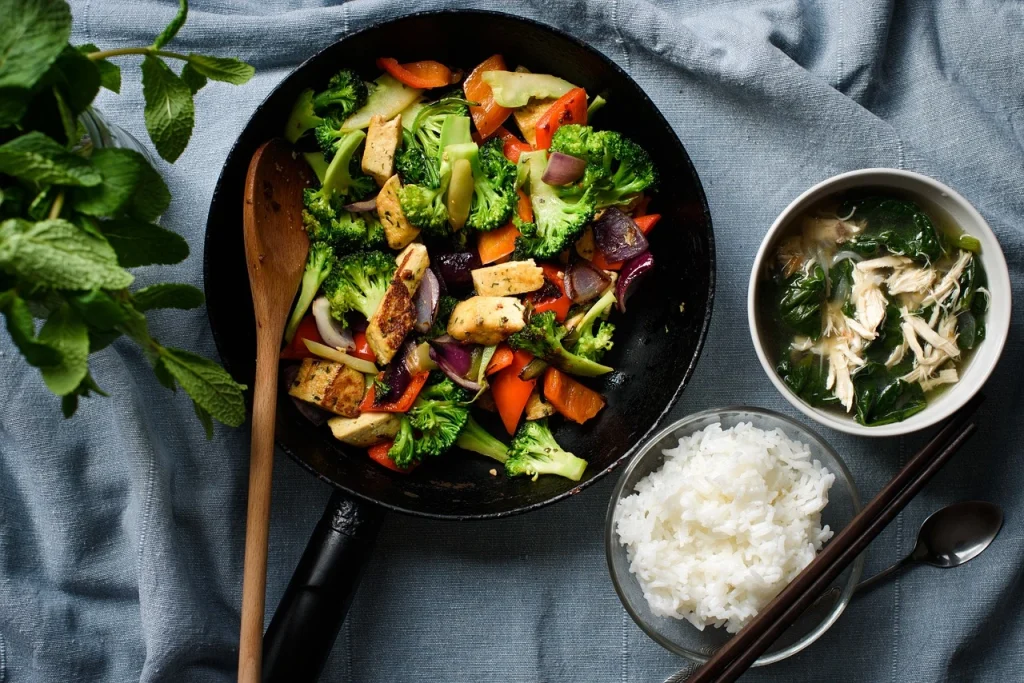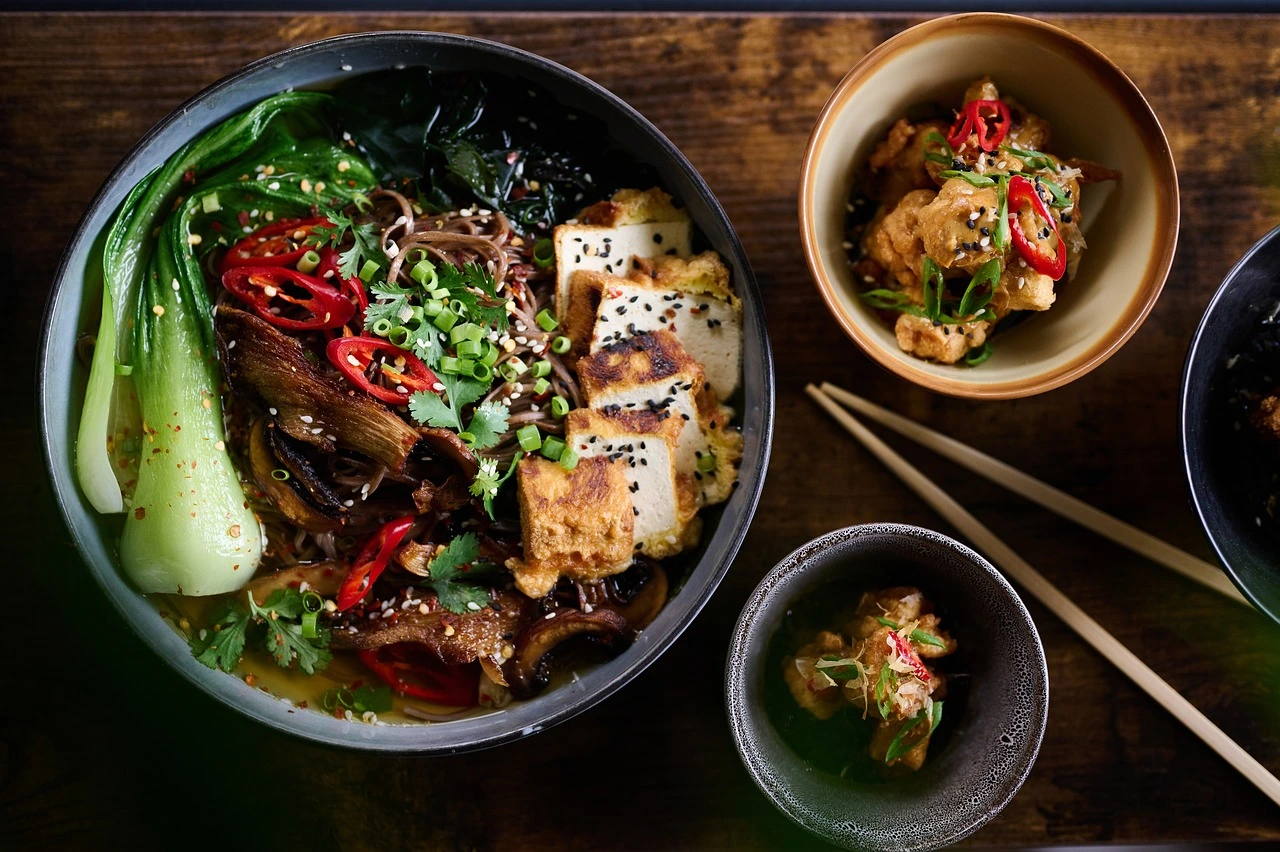Tofu soup, a comforting and nourishing dish, holds a revered place in various culinary traditions around the world. Born from the humble soybean, tofu serves as the cornerstone of this versatile soup, offering a canvas for a myriad of flavors and ingredients to come together harmoniously.This introduction will explore the origins of tofu soup, its cultural significance, and the diverse variations that exist across different regions and cuisines.
Table of Contents

Introduction To Origins and Cultural Significance
Tofu soup finds its roots in ancient China, where tofu, also known as bean curd, has been a dietary staple for over two millennia. Initially discovered by accident during the Han dynasty, tofu quickly gained popularity due to its versatility, affordability, and nutritional value. As tofu spread across East Asia, it became a cornerstone of various culinary traditions, including Japanese, Korean, and Southeast Asian cuisines.
Culturally, tofu soup holds significance beyond its role as a mere sustenance. In many Asian cultures, it symbolizes health, longevity, and prosperity. It often features prominently in celebratory meals, festivals, and religious ceremonies, reflecting its revered status in society.
Historical Evolution of Tofu Soup
The historical evolution of tofu soup mirrors the broader culinary developments and cultural exchanges that have occurred throughout history. Initially, tofu soup was a simple peasant dish, consisting of tofu simmered in water with basic seasonings such as salt and herbs.
Over time, as culinary techniques evolved and trade routes expanded, tofu soup began to incorporate a wider variety of ingredients, including vegetables, meats, seafood, and aromatic spices. Each region put its own unique spin on tofu soup, resulting in diverse interpretations and regional specialties.
In modern times, tofu soup has evolved beyond its humble origins to become a beloved comfort food enjoyed by people around the world. It has also found its way onto the menus of fine dining establishments, where chefs showcase its versatility and culinary potential through innovative preparations and presentations.
Key Ingredients and Varieties of Tofu
Tofu, the star ingredient of tofu soup, comes in various forms and textures, each lending itself to different culinary applications. The most common varieties of tofu include:
- Silken Tofu: Smooth and custard-like in texture, silken tofu is often used in soups, stews, and desserts due to its delicate consistency.
- Soft Tofu: Slightly firmer than silken tofu, soft tofu is versatile and suitable for a wide range of dishes, including soups, stir-fries, and salads.
- Firm Tofu: With a denser texture and higher protein content, firm tofu holds its shape well during cooking and is ideal for grilling, frying, or adding to hearty soups and curries.
- Extra-Firm Tofu: Densest of all, extra-firm tofu is well-suited for dishes that require a sturdy texture, such as stir-fries, kebabs, and tofu scrambles.
In addition to tofu, key ingredients commonly found in tofu soup include broth (vegetable, chicken, or seafood), vegetables (such as mushrooms, spinach, and bok choy), aromatics (garlic, ginger, and scallions), and seasonings (soy sauce, miso, and chili paste).
Nutritional Benefits of Tofu Soup
Tofu soup offers a plethora of nutritional benefits, making it a wholesome and nourishing addition to any diet. Tofu itself is rich in protein, essential amino acids, iron, calcium, and other vitamins and minerals. It is also low in saturated fat and cholesterol, making it a heart-healthy alternative to meat-based soups.
Moreover, tofu soup is highly customizable, allowing for the inclusion of a wide variety of vegetables, herbs, and spices, which further enhance its nutritional profile. Depending on the ingredients used, tofu soup can be tailored to meet dietary preferences and restrictions, including vegan, vegetarian, gluten-free, and low-carb diets.
Overall, tofu soup provides a satisfying and flavorful way to incorporate essential nutrients into one’s diet while appealing to a diverse range of tastes and dietary needs. Its versatility, cultural significance, and nutritional benefits make it a timeless classic that continues to stand the test of time in the culinary world.
Exploring the Rich Tapestry of Tofu Soup in Asian Cuisine
Tofu soup, a beloved dish deeply ingrained in Asian culinary heritage, showcases the remarkable diversity and ingenuity of regional cuisines. From the bustling streets of Tokyo to the bustling markets of Seoul, tofu soup delights diners with its comforting warmth, nourishing ingredients, and exquisite flavors. In this blog post, we embark on a culinary journey to explore the rich tapestry of tofu soup in Asian cuisine, uncovering its regional variations, traditional preparation methods, and modern interpretations in fusion cuisine.
Regional Variations and Specialties
Across Asia, tofu soup manifests in a myriad of regional variations, each reflecting the unique culinary traditions, local ingredients, and cultural influences of its respective region. Here are just a few examples of tofu soup specialties from around Asia:
- Japanese Miso Soup: A cornerstone of Japanese cuisine, miso soup features tofu cubes gently simmered in a savory broth made from fermented soybean paste (miso), dashi stock, and an array of seasonal vegetables, seaweed, and tofu varieties. This simple yet soul-satisfying soup is enjoyed as a comforting staple in Japanese households and is often served as part of a traditional breakfast or as a side dish in multi-course meals.
- Korean Sundubu Jjigae: Hailing from Korea, sundubu jjigae is a spicy tofu stew that packs a punch with its fiery broth, tender tofu, and an assortment of vegetables, seafood, and meats. Typically served bubbling hot in a stone pot, sundubu jjigae is prized for its bold flavors, hearty texture, and invigorating warmth, making it a popular choice for cold winter days or rainy evenings.
- Chinese Hot and Sour Soup: Originating from the Sichuan province of China, hot and sour soup is a tantalizing blend of tangy, spicy, and savory flavors. This iconic dish features silken tofu, bamboo shoots, wood ear mushrooms, and shredded pork or chicken, simmered in a fragrant broth seasoned with vinegar, soy sauce, chili paste, and aromatic spices. Renowned for its invigorating qualities and ability to stimulate the appetite, hot and sour soup is a perennial favorite in Chinese cuisine, especially during festive occasions and celebratory feasts.
- Thai Tom Yum Soup: Bursting with vibrant colors and bold flavors, tom yum soup is a quintessential Thai dish that showcases the harmonious balance of sweet, sour, salty, and spicy elements. While traditionally made with shrimp or chicken, tofu can be added to tom yum soup to provide a satisfying protein boost and creamy texture. Infused with fragrant herbs, lemongrass, galangal, kaffir lime leaves, and bird’s eye chilies, tom yum soup is a culinary tour de force that captivates the senses and leaves a lasting impression on the palate.
These are just a few examples of the diverse array of tofu soup specialties found across Asia, each offering a unique culinary experience that celebrates the rich tapestry of flavors, textures, and ingredients inherent to its respective region.
Traditional Preparation Methods
Traditional preparation methods for tofu soup vary depending on the cultural practices and culinary traditions of each region. However, there are some common techniques and principles that are shared across Asian cuisines:
- Broth: The foundation of tofu soup is often a flavorful broth made from scratch using ingredients such as dashi (Japanese stock made from bonito flakes and kombu seaweed), anchovies, chicken, pork bones, or vegetables. The broth is simmered slowly to extract maximum flavor and depth.
- Tofu: Tofu, the star ingredient of tofu soup, is typically cut into cubes or slices and added to the simmering broth. The choice of tofu variety (silken, soft, firm, or extra-firm) depends on personal preference and the desired texture of the soup.
- Aromatics and Seasonings: Aromatics such as garlic, ginger, onions, and scallions are often sautéed or added directly to the broth to infuse it with flavor. Seasonings such as soy sauce, miso, fish sauce, chili paste, and rice wine vinegar are used to enhance the taste and complexity of the soup.
- Vegetables and Proteins: A variety of vegetables, meats, seafood, and tofu are added to tofu soup to create a well-balanced and nutritious meal. Common ingredients include mushrooms, spinach, bok choy, seaweed, tofu skin, shrimp, clams, chicken, pork, beef, and eggs.
- Garnishes: Tofu soup is often garnished with fresh herbs, such as cilantro, Thai basil, or shiso leaves, to add a burst of color and freshness to the dish. Other garnishes may include sliced chili peppers, lime wedges, toasted sesame seeds, or crispy fried shallots.
These traditional preparation methods highlight the meticulous attention to detail and culinary expertise required to create tofu soup dishes that are bursting with flavor, aroma, and visual appeal.
Modern Interpretations and Fusion Cuisine
In recent years, chefs and home cooks alike have begun to experiment with tofu soup, incorporating innovative techniques, global ingredients, and fusion flavors to create modern interpretations of this timeless classic. Here are some examples of modern interpretations and fusion cuisine featuring tofu soup:
- Tofu Ramen: A fusion of Japanese ramen and tofu soup, tofu ramen features chewy ramen noodles bathed in a rich, savory broth infused with miso, soy sauce, and sesame oil. Topped with soft-boiled eggs, sliced pork belly, bamboo shoots, nori seaweed, and cubes of silken tofu, tofu ramen offers a satisfying and comforting meal that’s perfect for chilly evenings.
- Tofu Pho: Inspired by the iconic Vietnamese noodle soup, tofu pho features aromatic broth simmered with spices such as star anise, cinnamon, cloves, and cardamom, along with fresh herbs, rice noodles, and tofu slices. Topped with bean sprouts, lime wedges, Thai basil, and jalapeño slices, tofu pho is a light and refreshing dish that’s bursting with vibrant flavors and textures.
- Tofu Laksa: A fusion of Malaysian laksa and tofu soup, tofu laksa features creamy coconut milk broth infused with aromatic spices, lemongrass, galangal, and chili paste, along with tofu puffs, rice vermicelli noodles, bean sprouts, and tofu cubes. Topped with shredded chicken, shrimp, tofu skin, and hard-boiled eggs, tofu laksa is a hearty and satisfying dish that’s sure to warm you up on a cold day.
- Spicy Tofu Soup with Kimchi: A fusion of Korean sundubu jjigae and Japanese miso soup, spicy tofu soup with kimchi features fiery broth simmered with gochujang (Korean chili paste), kimchi, garlic, and ginger, along with soft tofu, mushrooms, and vegetables. Topped with a raw egg yolk, sliced scallions, and sesame seeds, spicy tofu soup with kimchi is a bold and flavorful dish that’s perfect for spice lovers.
These modern interpretations and fusion cuisine dishes demonstrate the endless culinary possibilities and creative combinations that can be achieved with tofu soup, inspiring chefs and home cooks to experiment with new ingredients, techniques, and flavor profiles.
Tofu Soup: A Vegan and Vegetarian Staple
Health Benefits of Tofu Soup:
- Rich Source of Plant-Based Protein
- High in Essential Nutrients such as Iron, Calcium, and Vitamin E
- Low in Saturated Fat and Cholesterol
- Provides Dietary Fiber for Digestive Health
- May Help Lower Risk of Chronic Diseases like Heart Disease and Type 2 Diabetes
Variety of Tofu Soup Recipes:
- Tofu and Vegetable Miso Soup
- Spicy Korean Soft Tofu Stew (Soon Tofu)
- Chinese Hot and Sour Tofu Soup
- Thai Coconut Curry Tofu Soup
- Japanese Clear Tofu Soup (Suimono)
Incorporating Tofu Soup into a Balanced Diet:
- Pair with Whole Grains like Brown Rice or Quinoa for a Complete Protein
- Serve with a Side of Steamed Vegetables or a Fresh Salad for Added Fiber and Nutrients
- Enjoy as Part of a Well-Balanced Meal with Lean Protein Sources like Beans or Lentils
- Use Lighter Broths and Limit Added Sodium for a Healthier Option
- Experiment with Different Flavor Profiles and Ingredients to Keep Meals Exciting and Nutritious
Health Conscious Approaches to Tofu Soup
Choosing Nutrient-Dense Ingredients:
- Opt for Fresh, Seasonal Vegetables to Maximize Nutrient Content
- Include a Variety of Colors for a Wide Range of Vitamins and Antioxidants
- Use Whole Grains and Legumes to Boost Fiber and Protein Content
- Select Low-Sodium Broths or Make Homemade Broths to Control Salt Intake
- Incorporate Herbs and Spices for Flavor without Adding Extra Calories or Sodium
Lighter Preparation Methods:
- Steam or Bake Tofu Instead of Frying for Lower Fat Content
- Use Vegetable Broths or Water-Based Cooking Methods to Reduce Caloric Density
- Minimize Added Sugars and Oils for a Healthier Option
- Experiment with Different Cooking Techniques such as Stir-Frying, Boiling, or Simmering for Varied Textures and Flavors
- Portion Control to Avoid Overeating and Maintain a Healthy Weight
Tofu Soup in Contemporary Dining
Trends in Tofu Soup Innovation:
- Fusion Cuisine Combining Traditional Tofu Soup Recipes with Global Flavors
- Creative Presentations and Plating Techniques to Elevate the Dining Experience
- Emphasis on Locally Sourced, Sustainable Ingredients for Ethical and Environmental Consciousness
- Incorporation of Seasonal and Artisanal Components for Freshness and Authenticity
- Adaptation to Dietary Preferences and Allergies, Including Gluten-Free, Nut-Free, and Soy-Free Options
Health-Focused Menus and Wellness Initiatives:
- Introduction of Lighter, Healthier Versions of Classic Tofu Soup Dishes
- Emphasis on Whole Foods and Plant-Based Ingredients for Nutrient Density
- Collaboration with Nutritionists and Dietitians to Develop Balanced Meal Options
- Inclusion of Nutritional Information on Menus for Informed Decision-Making
- Promotion of Mindful Eating Practices and Conscious Consumption Habits for Overall Well-Being
Tofu Soup: Tips for Home Cooking Success
Selecting Quality Ingredients:
- Choose Organic, Non-GMO Tofu for Optimal Flavor and Nutrition
- Pick Fresh, Seasonal Vegetables from Local Farmers’ Markets or Produce Stands
- Read Labels Carefully to Avoid Added Sugars, Preservatives, and Artificial Ingredients
- Invest in High-Quality Broths or Make Homemade Broths for Richer Flavor
- Experiment with Different Tofu Textures and Varieties to Suit Personal Preferences
Mastering Preparation Techniques:
- Practice Proper Knife Skills for Uniformly Chopped Vegetables and Tofu
- Learn Basic Cooking Methods such as Sauteing, Boiling, and Simmering for Versatile Soups
- Develop an Understanding of Flavor Profiles and Seasoning to Balance Taste and Texture
- Adjust Cooking Times and Temperatures to Achieve Desired Consistency and Doneness
- Taste Test Frequently and Adjust Seasonings as Needed for a Perfectly Seasoned Soup
Also Check:
- Alexia Sweet Potato Fries Air Fryer
- Malibu Barbie Drink
- Best Vegeterian Air Fryer Stuffed Peppers 2024
- Best Key Lime Pie Shot 2024
Conclusion
Tofu soup has undoubtedly earned its place as a vegan and vegetarian staple, offering a myriad of health benefits, culinary possibilities, and creative innovations. Whether enjoyed at home, in contemporary dining establishments, or as part of health-conscious meal plans, tofu soup continues to inspire and delight with its versatility, flavor, and nourishing qualities.
As we navigate the ever-changing landscape of food trends and dietary preferences, one thing remains constant: the timeless appeal of tofu soup as a wholesome, satisfying, and delicious meal option for individuals of all ages and backgrounds. So why not embrace the magic of tofu soup in your own kitchen and experience the joy of creating and savoring this beloved culinary classic? With a few simple ingredients, a dash of creativity, and a sprinkle of culinary know-how, you too can enjoy the nutritious goodness and comforting warmth of tofu soup whenever the craving strikes.

